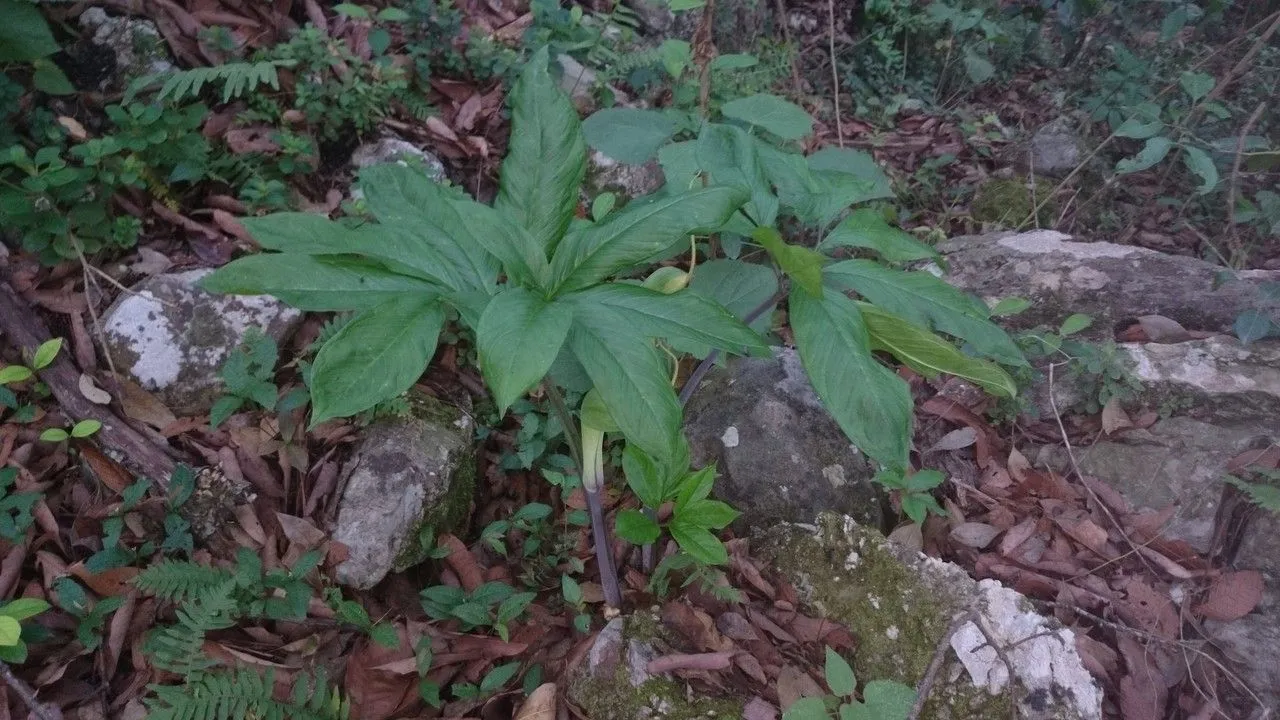
Author: (L.) Schott
Bibliography: H.W.Schott & S.L.Endlicher, Melet. Bot.: 17 (1832)
Year: 1832
Status: accepted
Rank: species
Genus: Arisaema
Vegetable: False
Observations: E. Canada to NE. Mexico
The Dragon-arum, scientifically known as Arisaema dracontium, is a striking and unique member of the Araceae family. This fascinating plant, formally described by H.W. Schott and S.L. Endlicher in their 1832 work “Melet. Bot.: 17”, is notable for its distinctive appearance and intriguing ecological characteristics.
Native to regions extending from Eastern Canada to Northeastern Mexico, the Dragon-arum thrives in a variety of habitats across its broad geographic range. This adaptability is one key to its survival and proliferation in diverse environments. The plant’s noteworthy presence in both Northern and Southern climates speaks to its resilience and versatility.
Arisaema dracontium is distinguished by its singular foliage and flower structures. Typically, the plant produces a solitary leaf that is divided into multiple, slender leaflets, radiating in an umbrella-like pattern which gives it a rather unique visual appeal. The flower, or inflorescence, of the Dragon-arum is equally remarkable – it features a spadix that extends from a hood-like spathe, resembling a dragon’s tongue, hence the common name Dragon-arum.
The life cycle and reproductive strategy of Arisaema dracontium are as captivating as its appearance. The plant oftentimes demonstrates remarkable sexual plasticity, with the ability to change gender based on environmental conditions and energy reserves, a fascinating adaptation that contributes to its reproductive success.
The Dragon-arum’s spadix emits a slight, foul odor which plays a crucial role in the plant’s pollination strategy. This scent attracts specific pollinators, such as flies, that are crucial for the plant’s reproduction. While not always pleasing to humans, this olfactory feature is an ingenious evolutionary adaptation that ensures the continuation of the species.
In conclusion, Arisaema dracontium or Dragon-arum stands out not only for its visually arresting morphology but also for its remarkable ecological adaptations. Its broad habitat range from Eastern Canada to Northeastern Mexico, unique reproductive strategies, and specialized pollination tactics all contribute to its enduring appeal among botanists and plant enthusiasts alike. Described by Schott in collaboration with Endlicher, the Dragon-arum remains a testament to the fascinating diversity and adaptability of the Araceae family.
Eng: dragon-arum, dragonroot, green dragon, green-dragon, greendragon, dragon-root
Fra: arisème dragon, ariséma dragon
Swe: stor kobrakalla
En: Dragon-arum, Dragonroot, Green-dragon, Green dragon, Greendragon, Dragon-root
Bg: Змиярникова аризема
Zh: 绿龙天南星
Fi: Puikkokärsäkalla
Fr: Dragon Vert, Arisème dragon, Ariséma dragon
De: Grüner Drachen
Es: Arisemas
Sv: Stor kobrakalla
Zh-tw: 緑龍天南星
Taken Dec 20, 2020 by o kaly (cc-by-sa)
Taken Aug 23, 2022 by steve bryant (cc-by-sa)
Taken Jul 19, 2019 by Carolyn Hufnagle (cc-by-sa)
Taken Jun 27, 2019 by M DD (cc-by-sa)
Taken Aug 26, 2022 by Bert Borchert (cc-by-sa)
Taken Sep 12, 2017 by Asif Jamil (cc-by-sa)
Taken Sep 18, 2022 by Elizabeth O’Brien (cc-by-sa)
Taken Nov 21, 2020 by ina Vandewijer (cc-by-sa)
Taken Sep 1, 2020 by Erin V (cc-by-sa)
Taken Sep 24, 2022 by suneska (cc-by-sa)
Taken Jan 10, 2014 by EOL − Susan Elliott (cc-by-nc)
Taken Apr 28, 2014 by EOL − Carlos Velazco (cc-by-nc)
Taken Jul 21, 2020 by AndreaMTB86 (cc-by-sa)
Taken Jun 9, 2020 by malot w (cc-by-sa)
Taken Jan 1, 1900 by EOL − Niehaus, T.F. (cc-by-nc-sa)
Taken May 17, 2004 by EOL − Steven J. Baskauf (cc-by-nc-sa)
Taken May 17, 2004 by EOL − Steven J. Baskauf (cc-by-nc-sa)
Taken Jun 16, 2008 by EOL − Ron Thomas (cc-by-nc-sa)
Taken Jan 1, 1900 by EOL − USDA NRCS Wetland Science Institute. (public)
Taken Jan 1, 1900 by EOL − Haug, E. (cc-by-nc-sa)
Taken Apr 28, 2014 by EOL − Carlos Velazco (cc-by-nc)
Taken May 18, 2014 by EOL − Erin Faulkner (cc-by-nc)
Taken Dec 22, 2014 by EOL − Sam Kieschnick (cc-by-nc)
Taken Dec 22, 2014 by EOL − Sam Kieschnick (cc-by-nc)
Taken Nov 4, 2014 by EOL − Andy Blair (cc-by-nc)
Growth habit>: Forb/herb
Family: Myrtaceae Author: (F.Muell.) K.D.Hill & L.A.S.Johnson Bibliography: Telopea 6: 402 (1995) Year: 1995 Status:…
Family: Rubiaceae Author: Pierre ex A.Froehner Bibliography: Notizbl. Bot. Gart. Berlin-Dahlem 1: 237 (1897) Year:…
Family: Sapindaceae Author: Koidz. Bibliography: J. Coll. Sci. Imp. Univ. Tokyo 32(1): 38 (1911) Year:…
Family: Asteraceae Author: A.Gray Bibliography: Pacif. Railr. Rep.: 107 (1857) Year: 1857 Status: accepted Rank:…
Family: Fabaceae Author: Medik. Bibliography: Vorles. Churpfälz. Phys.-Ökon. Ges. 2: 398 (1787) Year: 1787 Status:…
Family: Aspleniaceae Author: (Cav.) Alston Bibliography: Bull. Misc. Inform. Kew 1932: 309 (1932) Year: 1932…